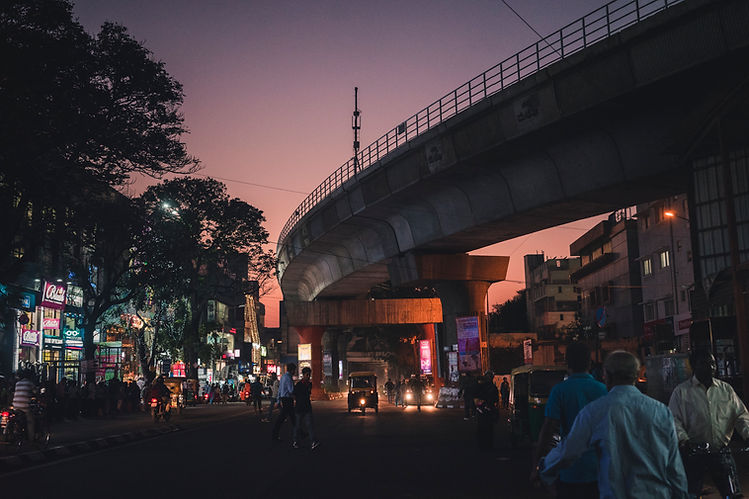

Bangalore
A Look into the Environment of
India's Tech City

Don't Breath the Air
One of the major headlines of India and the environment concerns the air. This pollution is considered a top killer of India and a major contributor to respiratory infections. National news has focused on places like Delhi and Mumbai, which hit record high air pollution levels. These are measured in two general levels: PM2.5 and PM10. This indicates the bracket of particle diameter in micrometers. PM2.5 refers to microscopic particles (diameter <2.5 micrometers) from ash, soot, and vehicle exhaust. This size is particularly dangerous due to its ability to enter the lungs and cause health complications. Its ability to be inhaled deeply into the small pores of the lungs leads to an increase of respiratory illnesses such as asthma, emphysema, and lung cancer.
The levels of pollution are demarcated by the Indian AQI, or Air Quality Index. It measures the ug/m3 concentrations of the particulate. Focusing on the PM2.5, ‘good’ is 0-30, ‘satisfactory’ is 31-60, ‘moderate’ is 61-90, ‘poor’ is 91-120, ‘very poor’ is 121-250, and ‘severe’ is 401+. The global concern for Delhi happened when the PM2.5 hit 700.

-
Gopalaswami, R.. "A Study on Effects of Weather, Vehicular Traffic and Other Sources of Particulate Air Pollution on the City of Delhi for the Year 2015." Journal of Environment Pollution and Human Health 4.2 (2016): 24-41.
What about Bangalore? How does it compare to the air crisis of Delhi? In a brief Greenpeace study published in 2017 assessing 168 cities of India, Bangalore ranked the 63rd most polluted when looking at the PM2.5. Using data collected from the World Health Orgnaization, or WHO, the values were compared to the National Ambient Air Quality Standards, or NAAQS. Bangalore was third most polluted when looking at the PM10. The highest contributor to air pollution in Bangalore is considered vehicle exhaust; the nitrogen oxide and unspent fuel contribute to both the PM2.5 and the PM10.
Anyone who has sat in Bangalore traffic would not be surprised.

Over the last ten years, the number of vehicles has more than doubled. With over 400,000 more cars on the road since 2007, the number of vehicles on the road is steadily increasing. The two-and-three-wheeled vehicles count for 70% of the vehicles in Bangalore. These numbers seem staggering when you consider that there is only one more Indian city with a higher vehicle count; New Delhi. The impact can be seen on both a large and small scope. Streets are clogged and congested with countless commuters; most of them covering their mouths with bandanas and scarves to avoid breathing in the fumes.

With this level of growth in the number of vehicles on the road, the civil infrastructure is readily overwhelmed. It slows traffic to stop-and-go all across the city, creating observably extreme travel times that can be clocked at 1 km/ hour. All of those vehicles sitting in idle contribute to the air pollution in a tangible way.

On a personal note, the commute to our internship was 13 kilometers. It would take one to two hours to travel. Almost mockingly, Goggle Maps would inform the same travel time by car as by walking. If it was an unfortunate Uber with no air conditioning, the open windows let us personally witness the physical stinging from breathing the air.
Like most environmental issues, there is never a single contributor. Another source of air pollution is the burning of waste. Be it plastics, wood, or leaves, the ash and soot that results is detrimental to health. Many households still use biofuels such as wood to cook and heat. Larger particles, such as visible soot and dust from cooled fires, contribute to PM10. Smaller particles, such as carbon and nitrates, are contributors to PM2.5.

Burning is also a readily used agricultural practice. Harvesting one-time crops like bananas leaves lots of stem and leaf debri. High in cellulose-dense fibers, it is much faster to burn these remains than to try and compost or recycle the materials. Many large, agricultural fires contribute to the increased air pollution around the edges of Bangalore. This may not be a year-round factor in the city’s measured air quality, but at the end of the harvest season, pillars of smoke can be seen from the city itself. The volume of this smoke is a contributor to the overall air pollution of the city.
There are a handful of solutions being implemented to help fight this problem. Unfortunately, there are heavy cultural
undertones that need to be adjusted first. To address the vehicle problem, some rickshaws are beginning to use biofuel, or even electric, fuel sources.

New cars sold in Bangalore have a lower emission than the older cars. An emission standard does exist for current vehicles, but there are many ways around this by paying for a passing certificate. Grassroots campaigns are trying to shift the cultural use of fire to handle garbage, discussed in greater detail in the fire article. This is unfortunately a large problem with no easy solution. One of the major environmental concerns of Bangalore, it may be the most abstract to inform the public about. It is also, quite possibly, the most difficult to make progress towards improving.
